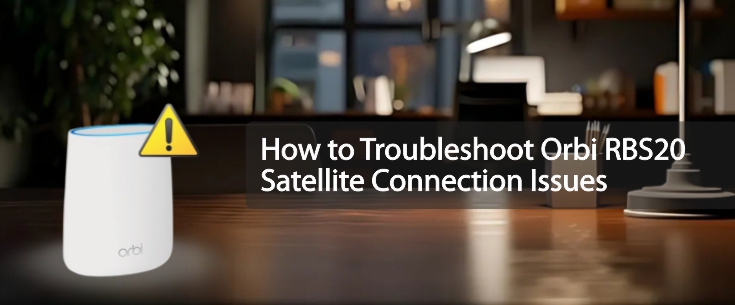How to Troubleshoot Orbi RBS20 Satellite Connection Issues
Isn’t it annoying? When the satellite lights are blinking, devices are facing an issue in connecting to the network, constant connection drop-offs and all of a sudden, your “mesh” network doesn’t seem as it was before.
Don’t worry, it can be fixed.
Therefore, this guide is for those who only want their Orbi satellite to connect and remain connected. It includes steps that are easy-to-follow. You don’t need any professional help to follow them. Dive in.
First things first: What’s wrong?
If your Orbi RBS20 satellite isn’t connecting properly, you can see one or more of these signs:
- The LED on the satellite stays amber or magenta for too long
- Your gadget continues losing WiFi even when you’re close to the satellite.
- The Orbi app or website claims the satellite is “offline.”
- The internet is slower than it should be, but devices can connect.
Does this sound familiar? That’s cool. Now, let’s talk about what you can do about it.
Step-by-Step: How to Fix Orbi RBS20 Connection Problems
1. Turn off and on the satellite
The oldest technique in the book works like a charm sometimes. Unplug the RBS20 satellite from power, wait 45 to 60 seconds, and then connect it back in. Let it reboot for roughly two to three minutes. The light will become white, then flicker, and eventually (hopefully) stay blue, which means everything is well.
If it remains yellow or purple, keep reading.
2. Sync the satellite back up with the router
This is how to do it manually:
- Press the Sync button on the main Orbi device, which is the router.
- After two minutes, press the Sync button on your RBS20 satellite.
The satellite should flicker white and then become solid blue when the sync is complete. Don’t worry if it becomes amber or magenta again. It might be a problem with the range or a glitch in the firmware.
3. Check Placement: Is your satellite placed too far away?
The Orbi satellite operates best when it is close to the router. We’re talking about 30 to 40 feet, with just a few substantial walls or floors in the way.
If you receive a steady blue light after syncing but the internet is still spotty, consider moving the satellite to a room or two away from the router. Don’t place it too near as well! It’s won’t help either. The aim is to balance, not overlap.
4. Update the Firmware
Old firmware may create all kinds of strange problems. To verify and make changes:
- Open a web browser and go to orbilogin.net or 192.168.1.1 to log in to the Orbi online site.
- Click on Admin, then Advanced, and then Firmware Update.
- Click the Check button. Install any updates that are available for your RBS20.
Check that both the router and the satellite are up to date, since certain upgrades require both to be on the same version.
5. Resetting the factory as a last resort
Yes, it’s time to reset if nothing else works.
This is how:
- Look for the reset pinhole on the rear of your RBS20.
- Press and hold with a paperclip or pin for approximately 10 seconds.
- Let go when the power LED begins to flicker orange.
After resetting, sync the satellite with the router again, exactly as in step 2. You may need to change some settings, but it can fix errors that keep coming back.
6. Check for interference again
WiFi may be messed up by things like cordless phones, baby monitors, and even microwaves. If your satellite is adjacent to any of these, you may want to move it.
Also, other big equipment, like TVs and speakers, might bounce signals off of them and mess up the mesh route. It might help to move things around a little.
7. If the Orbi App doesn’t crash, check it out.
The Orbi app might be problematic, but when it works, it’s helpful. Use it to:
- Make sure the signal between the router and the satellite is strong
- Find “dead spots”
- Test the speed of each device separately
If it continues crashing, try using the browser instead. It’s more stable anyhow.
8. Nothing yet? If you can, try Wired Backhaul.
Connect your RBS20 satellite to the router via a LAN connection if your home is connected via ethernet or you can run a cable for a short time. This creates a wired backhaul, which is like a direct connection between the router and the satellite.
Once everything is linked, restart it all. Wired backhaul fixes a lot of problems with wireless stability and can be your best alternative if synchronization keeps failing.
FAQs
1. How can I determine whether my Orbi RBS20 is operating right?
You’re okay if the LED goes solid blue after synchronizing and remains that way. Also, devices that are close to the satellite should have strong WiFi and work well.
2. What does it signify when the Orbi satellite has a steady amber light?
It implies that the connection to the router isn’t very strong. You may have to relocate the satellite closer or get rid of the interference.
3. Is it possible to employ more than one RBS20 satellite?
Yes. You may add additional satellites if your network can handle them. For the optimum coverage, sync one at a time and give them some room.
4. Will resetting the satellite erase all of my network?
Nope. Resetting the satellite only changes that one device. Unless you reset the complete system, your primary Orbi router and settings remain the same.
Wrapping It Up
The Orbi RBS20 is a good small satellite when it works, but it may be a pain occasionally. If your devices are losing sync, flashing strange colors, or merely ghosting, the remedies above generally work.
What is the worst case? A reset clears up most problems. Best case? It just needed a power cycle or a firmware upgrade to function.
Don’t be scared to use that little reset button if nothing else works. Take your time and move around the device to see where it works the best.

